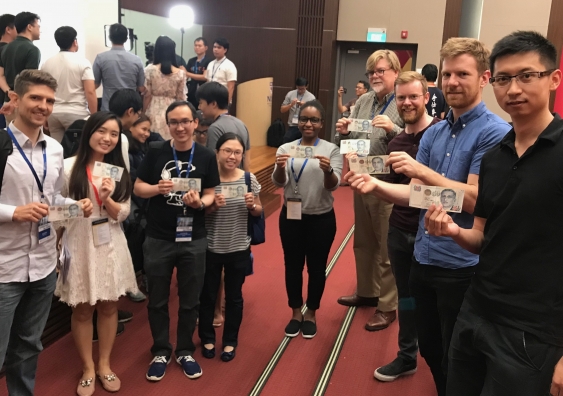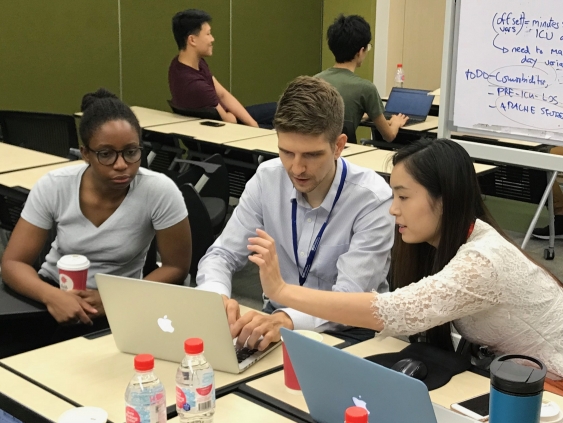How big data can change intensive care
A UNSW team of data scientists and clinicians have won the top prize at the second annual Healthcare Artificial Intelligence Datathon held at the National University of Singapore.
A UNSW team of data scientists and clinicians have won the top prize at the second annual Healthcare Artificial Intelligence Datathon held at the National University of Singapore.

Lucy Carroll
UNSW External Communications
9385 8732, 0402 005 319
l.carroll@unsw.edu.au
A team of data scientists, researchers and clinicians from UNSW Sydney have won a major prize at the second annual Healthcare Artificial Intelligence Datathon held at the National University of Singapore (NUS).
The two-day event – organised jointly by the National University Health System (NUHS), Massachusetts Institute of Technology (MIT) and NUS – hosted more than 200 local and international data scientists and clinicians last weekend to address current problems in healthcare with the latest machine learning and artificial intelligence technologies.
The joint UNSW-NUS team won first prize in the Critical Care Track, competing against eight other teams to analyse clinical data contained in the MIT/Philips eICU Collaborative Research Database, comprising information on more than 200,000 patients treated in intensive care units in US hospitals over the past five years.
The UNSW-NUS team included researchers Oluwadamisola Sotade, Dr Mark Hanly and Oisin Fitzgerald from UNSW’s Centre for Big Data Research in Health, Dr Tim Churches, data scientist from the Ingham Institute for Applied Medical Research and UNSW South Western Sydney Clinical School, and Dr Peter Straka from UNSW Mathematics and Statistics.
“The installation of next-generation electronic medical records systems in ICUs and throughout hospitals enable very sophisticated machine-learning and artificial intelligence algorithms to be developed to assist busy clinicians in patient care and treatment decision making.” said Dr Churches. “The Datathon fostered vital collaboration between clinicians, researchers and statisticians with a focus on big data and the challenges in extracting knowledge from such health records.
“This is the first time we have worked with such highly detailed data from intensive care settings accumulated over the entire length of each patient’s stay in the ICU. We analysed all types of treatment interventions, such as medication given to patients, including ventilation support as well as blood pressure records, temperatures and clinical biochemistry,” said Dr Churches.

The UNSW/NUS team competing at the NUS-MIT AI in Health Datathon, Singapore. Photo: UNSW
In the past, much of the data available has been collected when a patient first arrives in ICU, with predictive models assuming prognostic factors don’t vary during the patient’s stay. Applying cutting-edge models to millions of rows of patient demographic, physiological, treatment and laboratory data, the team found that the importance of prognostic factors in predicting mortality does in fact change significantly over the course of a stay in ICU. For example, abnormal mean arterial blood pressure has greater importance in predicting a poor outcome with each successive day of a stay in ICU.
Over the past three years, intensive care units in Australia and Singapore have installed similar clinical information systems to those used to collect the data analysed by the UNSW-NUS team during the Datathon, and thus this work paves the way for development of algorithms based on Australian and Singaporean ICU data.
Professor Louisa Jorm, Director of UNSW's Centre for Big Data Research in Health, said the huge amounts of data routinely captured by machines in ICU could be key in predicting patient outcomes.
“Current ways of predicting outcomes in ICUs are done at the point of admission. What the winning team at the Datathon examined was if factors that predict mortality change over the course of the stay. Examining this data could help improve patient assessment and care, for example helping to personalise treatment over the course of the ICU stay and improve patient survival”,” said Professor Jorm.
Dr Churches said: “We need to develop more sophisticated models using detailed data captured by electronic medical records in ICUs. This could then be used for quality assurance, in comparing ICUs in different hospitals, and for better understanding when the patient is likely to be discharged.”